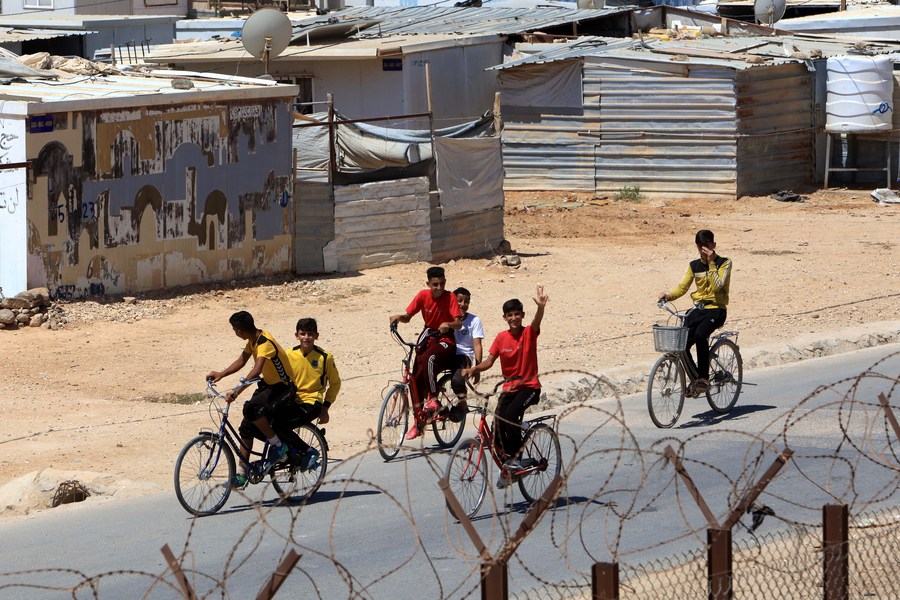Located in the desert of northeastern Jordan, some 10 km from the border with Syria, the Zaatari camp is the largest Syrian refugee camp in the kingdom, temporarily accommodating more than 80,000 refugees who fled the Syrian war.
A decade after the camp first opened its gates in late July 2012, most camp residents still consider going home a distant dream, though their homes are only miles away from their temporary shelters.

Syrian refugees are seen at Zaatari refugee camps, Jordan, on Aug. 2, 2022. (Photo by Mohammad Abu Ghosh/Xinhua)
Ibtisam al-Zoubi, a 34-year-old mother of four from the Syrian city of Daraa, has never expected her life as a refugee would last for 10 years when she sought safety in the camp soon after its opening.
"When I left Syria, I thought it would be only two months at most, so I didn't even bring my youngest daughter's shoes," she told Xinhua.
Al-Zoubi is one of the millions of Syrians who were forced to leave their home after the outbreak of the Syrian war in 2011.

A Syrian refugee girl is seen at Zaatari refugee camps, Jordan, on Aug. 2, 2022. (Photo by Mohammad Abu Ghosh/Xinhua)
Jordan, which borders Syria, has hosted more than 1.3 million Syrian refugees since 2011. The influx of the refugees has increased the burden on the country's budget, particularly on subsidized commodities and the water, education, health and energy sectors, Jordanian Minister of Planning and International Cooperation Nasser Shraideh said in July.
To help the Syrian refugees, the Jordanian government and the United Nations High Commissioner for Refugees (UNHCR) have set up camps across the kingdom, with the Zaatari camp being the largest.
Upon her arrival at the camp, Al-Zoubi lived in a tent without enough daily necessities, dealing with a number of difficulties such as a lack of water, a sweltering summer, and chilly weather in winter.
She did, however, gained peace and security, which was something more important to her. "It felt like someone saved my child from a well," she burst into tears while recalling her days at the camp.

Syrian refugees are seen at Zaatari refugee camps, Jordan, on Aug. 2, 2022.(Photo by Mohammad Abu Ghosh/Xinhua)
Over the past 10 years, the refugee camp has witnessed some changes. Most of the tents were replaced by prefabricated shelters, while schools and hospitals were built.
Mohammad Taher, a UNHCR external relations officer, said the changes in the past 10 years were not worth celebrating because "the Syrian refugee issue is still not comprehensively resolved."
Since the establishment of the refugee camps, the UNHCR regards them as an emergency measure rather than a permanent resettlement sites or solution to refugees' predicament, according to Taher.
Taher said it was important to "find a way for refugees to develop in the long run" as their needs for living a dignified life are on the rise.
The majority of the camp's residents still want to return to Syria in the future, while most of them believe Syria is still not safe at present, according to a survey conducted by the UNHCR among the refugee residents of the camp recently.
"I'm not willing to return to the fear and the horror that I witnessed," said al-Zoubi.
Jordanian analysts believe that the deteriorating economic situation in Syria, which is worsened by U.S. sanctions, is another reason why Syrian refugees are unwilling to go home.
"The U.S. unilateral sanctions played a negative role" in Syria's economic woes, which could last for years, said Saeb Rawashdeh, an Amman-based political analyst at the Jordan Press Foundation.
Xinhua
















Comments About This Article
Please fill the fields below.